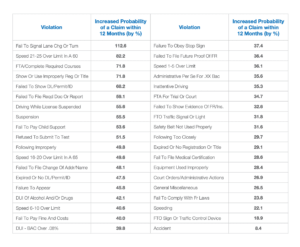With the recent 11.8% jump in insurance quote rates across the nation, companies are shopping around with the hope of finding more affordable commercial auto premiums, only to discover that they have an even bigger problem on their hands – hidden driver risk. Why? There are many companies that still rely on traditional driver risk management processes. These processes typically consist of manually pulling MVRs on an infrequent basis, such as the reliance on an annual MVR review. And the reasoning behind it does make sense in theory, as manually pulling MVRs is an incredibly time-consuming, expensive and tedious process.
But far beyond the administrative burden of infrequent, manual MVR pulls is the costly issue of hidden driver risk that it creates – increasing the likelihood of future crashes and expensive claims. This exposure in turn increases the cost of companies’ commercial auto premiums, as insurers need to charge more to profitably insure them.
Below, we explore the costly repercussions of infrequent MVR pulls and unreported driver violations.
Download Our FREE Guide:
How to Revolutionize Your Approach to Mitigating Driver Risk
The Annual MVR Review & The Visibility Gap
Relying on an annual MVR review is a dangerous tactic. The moment a driver gets behind the wheel after an MVR pull, companies lose all visibility into the risk that driver presents for the rest of the year. With this approach, companies have a frightening lack of knowledge of driver behavior across their entire fleet. This creates a “visibility gap” that effectively eliminates any form of proactive action they may be able to take. The riskiest drivers remain undiscovered, exposing companies to immense liability.
Consider this scenario – a company hires a new driver and pulls their MVR on January 1. That driver receives a DUI on January 8, but since the company pulls annual MVRs, the incident will remain undiscovered (along with any others incurred) until January 1 of the next year. Worrisome, isn’t it?
Unreported Violations Increase Exposure
Manually pulling MVRs provides some insight, but not all that’s needed. Unreported incidents like parking lot fender benders or backing up into a light pole may be equally as important to companies as a serious crash.
For example – if the majority of the role a driver is hired for requires backing up a vehicle multiple times a day, and that driver has five unreported parking lot fender benders, this could be a sign of things to come. How are companies tracking this information?
Is it part of a company’s MVR review process to double-check that specific drivers haven’t been involved in other incidents? If tracked in a spreadsheet or other program, they’re adding additional time to the annual or bi-annual review process – but it’s also a greater risk to skip out on such detailed information, as a history of reckless, careless, inattentive or negligent driving increases the likelihood of a crash by 64%.
Hidden Risk Just Creates More Risk
Every mile an at-risk employee is driving without intervention puts companies at greater risk. To put this in perspective, take a look at our Leading Indicators Chart below. Our crash prediction study correlated MVR events with crashes, calculating the increased probability of a claim occurring within the 12 months following a specific violation.

Let’s highlight the first violation listed on the chart – receiving a violation for failing to signal a lane change increases the probability of a claim within the next year by almost 113%.
Companies relying on manual MVR pulls are missing vital data indicative of further reckless behavior – behavior that most likely requires remedial driver training or some other form of intervention.
Uncovering Risk Requires a Proactive Solution
As commercial auto sees rewards and settlements that regularly surpass $10 million, companies can’t afford to let violations slip through the cracks without intervention. The auto insurance space has been particularly impacted by social inflation, where insurers’ claim costs have risen above general economic inflation. In 2019, the number of U.S. verdicts resulting in $20 million or more was up more than 300% from the annual average from 2001 to 2010.
With this in mind, companies need to be less concerned about finding the cheapest premiums, and more proactive in ensuring they have a good handle on their employees’ driving behaviors.
In order to successfully track driver risk and reduce exposure, companies need full insight into their entire driver population. This means receiving continuous alerts of driver violations and license status changes, so they can take action to remediate the situation as soon as possible.
To learn more about how companies can expand their insight into risk beyond what their annual MVR review strategy brings, download our white paper, Revolutionize Your Approach to Mitigating Driver Risk.

